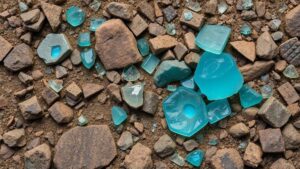Searching for meteorites scattered across the flat expanses of the Jornada del Muerto desert.
Searching for Meteorites in the Jornada del Muerto Desert
The Jornada del Muerto, a sprawling desert in New Mexico, is not only a site of historical significance but also a hotspot for rockhounds and mineral collectors. With its flat, open expanses and exposed geological features, it presents an intriguing opportunity for those interested in searching for meteorites–fragments of space debris that have landed on Earth. This article will guide enthusiasts through the process of meteorite hunting in this unique desert landscape, examining the best practices, tools, and considerations for collectors.
The Appeal of Meteorites
Meteorites offer a tangible connection to the cosmos, containing clues about the early solar system. For mineral collectors, they are not only aesthetically pleasing but also scientifically valuable. The study of meteorites has revealed significant information about planetary formation. According to the Meteoritical Society, more than 60,000 official meteorite finds and falls have been cataloged, but many are still undiscovered in locations like the Jornada del Muerto.
Understanding the Jornada del Muerto
The Jornada del Muerto, translating to Journey of the Dead, spans roughly 150 miles and consists of a desert landscape characterized by caliche surfaces, dry riverbeds, and sparse vegetation. arid climate and lack of vegetation make it easier to spot meteorites against the ground. Also, the regions volcanic activity millions of years ago may have contributed to a diverse geological framework, increasing the probability of meteorite finds.
Tips for Successful Meteorite Hunting
Preparation and Research
Before heading out, preparedness is crucial. Proper research can significantly enhance your chances of locating meteorites. Here are steps to consider:
- Study Meteorite Types: Familiarize yourself with the different types of meteorites, such as chondrites, achondrites, and iron meteorites. Each type has unique characteristics that can help you identify them on the ground.
- Map Your Location: Use geological maps to identify areas where meteorites are likely to be found. Look for places with exposed bedrock or minimal soil cover, as these tend to reveal surface meteorites.
Tools of the Trade
Equipping yourself with the right tools can also make your meteorite hunting experience more fruitful. Essential tools include:
- Magnet: Many metallic meteorites are magnetic. A simple pocket magnet can help in identifying them quickly.
- Field Guide: Carry a field guide with clear images and descriptions of meteorites, alongside a rock identification guide.
- Hand Lens: Use a hand lens to examine potential finds closely, looking for features like regmaglypts (thumbprint-like impressions) that are indicative of meteorite material.
When to Search
The best time to search for meteorites in the Jornada del Muerto is during the cooler months, typically from late fall to early spring. This timing ensures a more comfortable hunting experience and avoids the extreme heat that can be prevalent in the summer months. Plan your expedition early in the day to make the most of the cooler temperatures.
Identifying Meteorites
Identifying a meteorite can be challenging, but there are several key characteristics to look for:
- Weight and Density: Meteorites are generally denser than Earth rocks. If it feels unusually heavy for its size, it may be a meteorite.
- Fusion Crust: A thin, dark exterior often covers meteorites, which forms as the object enters the Earth’s atmosphere and heats up.
- Chondrules: Many chondrites contain small, round grains called chondrules. The presence of these can help confirm the specimens extraterrestrial origin.
Preserving Your Finds
Once you have identified and collected meteorites, proper preservation is essential to maintain their condition. Here are some actionable takeaways:
- Storage: Store meteorites in a cool, dry place, ideally in a protective container to prevent oxidation and damage.
- Documentation: Keep a detailed log of each find, including the location, date, and any features noted during identification. This information is invaluable for potential future studies.
Conclusion
The search for meteorites in the Jornada del Muerto can be a rewarding endeavor for both novice and experienced rockhounds. With preparation, the right set of tools, and knowledge of identifying characteristics, collectors can enhance their likelihood of uncovering these fascinating remnants of the universe. As with any field pursuit, patience and persistence are key. So gear up, head out, and enjoy the adventure of finding a piece of the cosmos in the vast New Mexico desert.



